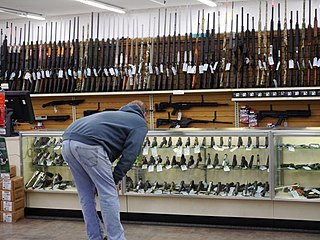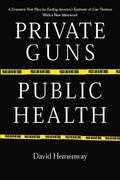
Gun control, or firearms regulation, is the set of laws or policies that regulate the manufacture, sale, transfer, possession, modification, or use of firearms by civilians.

More Guns, Less Crime is a book by John R. Lott Jr. that says violent crime rates go down when states pass "shall issue" concealed carry laws. He presents the results of his statistical analysis of crime data for every county in the United States during 29 years from 1977 to 2005. Each edition of the book was refereed by the University of Chicago Press. As of 2019, the book is no longer published by the University of Chicago Press. The book examines city, county and state level data from the entire United States and measures the impact of 13 different types of gun control laws on crime rates. The book expands on an earlier study published in 1997 by Lott and his co-author David Mustard in The Journal of Legal Studies and by Lott and his co-author John Whitley in The Journal of Law and Economics, October 2001.
Arthur L. Kellermann is an American physician and epidemiologist. Until his resignation in November 2022, he served as a professor of emergency medicine at the VCU School of Medicine, senior vice president of health sciences for Virginia Commonwealth University, and CEO of the VCU Health System. He was formerly professor and dean of the F. Edward Hébert School of Medicine at the Uniformed Services University of the Health Sciences. Kellerman served as director of the RAND Institute of Health and founded the department of emergency medicine at Emory University and the Center for Injury Control at Rollins School of Public Health. His writings include 200 publications on various aspects of emergency cardiac care, health services research, injury prevention and the role of emergency departments in providing health care to the poor. Kellermann is known for his research on the epidemiology of firearm-related injuries and deaths, which he interpreted not as random, unavoidable acts but as preventable public-health priorities. Kellermann and his research have been strongly disputed by gun rights organizations, in particular by the National Rifle Association of America, although Kellermann's findings have been supported by a large body of peer-reviewed research finding that increasing gun ownership is associated with increased rates of homicide and violence.

Gun politics is defined in the United States by two primary opposing ideologies concerning the private ownership of firearms. Those who advocate for gun control support increasingly restrictive regulation of gun ownership; those who advocate for gun rights oppose increased restriction, or support the liberalization of gun ownership. These groups typically disagree on the interpretation of the text, history and tradition of the laws and judicial opinions concerning gun ownership in the United States and the meaning of the Second Amendment to the Constitution of the United States. American gun politics involves these groups' further disagreement concerning the role of firearms in public safety, the studied effects of ownership of firearms on public health and safety, and the role of guns in national and state crime.

Brady: United Against Gun Violence is an American nonprofit organization that advocates for gun control and against gun violence. It is named after former White House Press Secretary James "Jim" Brady, who was permanently disabled and later died in 2014 as a result of the Ronald Reagan assassination attempt of 1981, and his wife Sarah Brady, who was a chairwoman of the organization from 1989 until her death in 2015.

A suicide method is any means by which a person may choose to end their life. Suicide attempts do not always result in death, and a non-fatal suicide attempt can leave the person with serious physical injuries, long-term health problems, and brain damage.
The Violence Policy Center (VPC) is an American nonprofit organization that advocates for gun control.
Tom Diaz is an American writer, lawyer, and public speaker on the gun industry and gun control issues. He was formerly senior policy analyst at the Violence Policy Center and is one of the more prominent advocates for a strict system of federal gun control in the United States.

The Eddie Eagle GunSafe program and its namesake character were developed by the National Rifle Association for children who are generally considered too young to be allowed to handle firearms. While maturity levels vary, the Eddie Eagle program is intended for children of any age from pre-school through third grade.

Gun violence is a term of political, economic and sociological interest referring to the tens of thousands of annual firearms-related deaths and injuries occurring in the United States. In 2022, up to 100 daily fatalities and hundreds of daily injuries were attributable to American gun violence. In 2018, the most recent year for which data are available, the Centers for Disease Control and Prevention's (CDC) National Center for Health Statistics reported 38,390 deaths by firearm, of which 24,432 were suicides. The national rate of firearm deaths rose from 10.3 people for every 100,000 in 1999 to 11.9 people per 100,000 in 2018, equating to over 109 daily deaths. In 2010, there were 19,392 firearm-related suicides, and 11,078 firearm-related homicides in the U.S. In 2010, 358 murders were reported involving a rifle while 6,009 were reported involving a handgun; another 1,939 were reported with an unspecified type of firearm. In 2011, a total of 478,400 fatal and nonfatal violent crimes were committed with a firearm.

Gun-related violence is violence committed with the use of a firearm. Gun-related violence may or may not be considered criminal. Criminal violence includes homicide, assault with a deadly weapon, and suicide, or attempted suicide, depending on jurisdiction. Non-criminal violence includes accidental or unintentional injury and death. Also generally included in gun violence statistics are military or para-military activities.

In 2018, the Small Arms Survey reported that there are over one billion small arms distributed globally, of which 857 million are in civilian hands. The survey stated that American civilians account for an estimated 393 million of the worldwide total of civilian held firearms, or about 120.5 firearms for every 100 American residents.

David Hemenway is a Professor of Health Policy at the Harvard School of Public Health. He has a B.A. (1966) and Ph.D. (1974) from Harvard University in economics. He is the director of the Harvard Injury Control Research Center and the Harvard Youth Violence Prevention Center. He is also currently a James Marsh Visiting Professor-at-Large at the University of Vermont. Hemenway has written over 130 articles and five books in the fields of economics and public health.
The State of Texas is considered to have some of the most relaxed gun laws in the United States. Public concerns over gun control in Texas have increased in recent years as Mexican drug cartels continue to commit violent crimes closer to Texas' stretch of the Mexico–United States border. They have also increased due to the number of incidents, including misuse of firearms stolen from other sources.

Defensive gun use (DGU) is the use or presentation of a firearm for self-defense, defense of others or, in some cases, protecting property. The frequency of incidents involving DGU and their effectiveness in providing safety and reducing crime are controversial issues in gun politics and criminology, chiefly in the United States. Different authors and studies employ different criteria for what constitutes a defensive gun use which leads to controversy in comparing statistical results. Perceptions of defensive gun use are recurring themes in discussions over gun rights, gun control, armed police, open and concealed carry of firearms.

Proposals for universal background checks would require almost all firearms transactions in the United States to be recorded and go through the National Instant Criminal Background Check System (NICS), closing what is sometimes called the private sale exemption. Universal background checks are not required by U.S. federal law, but at least 21 states and the District of Columbia currently require background checks for at least some private sales of firearms.

The Trace is an American non-profit journalism outlet devoted to gun-related news in the United States. It was established in 2015 with seed money from the largest gun control advocacy group Everytown for Gun Safety, which was founded by former New York City mayor Michael Bloomberg, and went live on 19 June of that year. The site's editor in chief is Tali Woodward.
Daniel W. Webster is an American health policy researcher and the director of the Center for Gun Policy and Research at Johns Hopkins University. He is also the deputy director for research at the Johns Hopkins Center for the Prevention of Youth Violence, and the first Bloomberg Professor of American Health at the Johns Hopkins Bloomberg School of Public Health. In 2016, he became the director of the Johns Hopkins-Baltimore Collaborative for Violence Reduction, a joint crime-fighting effort between Johns Hopkins and the Baltimore Police Department.
The Dickey Amendment is a provision first inserted as a rider into the 1997 omnibus spending bill of the United States federal government that mandated that "none of the funds made available for injury prevention and control at the Centers for Disease Control and Prevention (CDC) may be used to advocate or promote gun control." In the same spending bill, Congress earmarked $2.6 million from the CDC's budget, the exact amount that had previously been allocated to the agency for firearms research the previous year, for traumatic brain injury-related research.
A child access prevention law makes it illegal for an adult to keep a gun in a place and manner so that a child can easily access and fire it. Proponents of these laws, such as the Law Center to Prevent Gun Violence in the United States, argue that they are effective at reducing accidental gun deaths among children, since they reduce accessibility and thereby risk. The National Rifle Association of America has lobbied against such laws, arguing that they are ineffective and infringe on the rights of gun owners to protect their homes.














